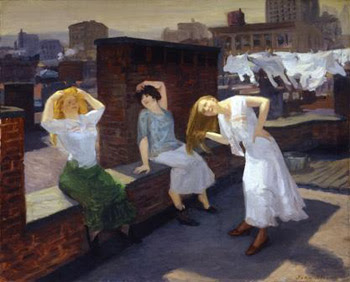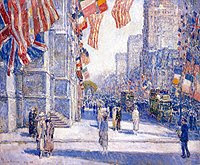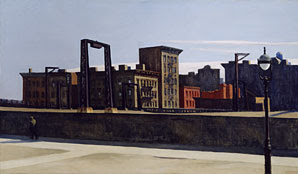I had time, just now, that quiet time, of reading the magazines that came in last week. Oh, the stolen deliciousness of it all. In
The New Yorker, I read of Oliver Sacks on his years dedicated, in large part, to experimenting with large doses of amphetamines, morning-glory seeds, LSD, morphine, and all other manner of neuro-shifters. I thought of all the Sacks I have read these many years, of the seeming innocence of his beguiling childhood memoir,
Uncle Tungsten: Memories of a Chemical Boyhood, of his great empathy for patients and ferns and other earthly beings. His
New Yorker essay delves, skips, and buries time before it rushes, headlong, toward its hard stop. Sacks had discovered a book on migraines and it had become important to him. He had a revelation about migraines. He ...
... had a sense of resolution, too, that I was indeed equipped to write a Liveing-like book, that perhaps I could be the Liveing of our time.
The next day, before I returned Liveing's book to the library, I photocopied the whole thing, and then, bit by bit, I started to write my own book. The joy I got from doing this was real—infinitely more substantial than the vapid mania of amphetamines—and I never took amphetamines again.
Writing books, Sacks suggests, saved him. The next story I read, an excerpt from D.T. Max's much heralded biography of David Foster Wallace (in
Newsweek), suggests how writing would and would not save this genius. The excerpt, which focuses on Wallace's early correspondence with Jonathan Franzen as well as his infatuation with Mary Karr, suggests that this book is well worth reading as a whole. I've always been a huge D.T. Max fan, and I'm certain I will learn from these pages.
In between the Sacks and the Wallace, I found two poems of interest. Joyce Carol Oates has a chilling, compelling poem in
The New Yorker called "Edward Hopper's '11 A.M.,' 1926"�worth reading from beginning to end. Oates was one of several authors who contributed to one of my favorite poetry collections (a gift from my sister) called
The Poetry of Solitude: A Tribute to Edward Hopper (collected and introduced by Gail Levin). Clearly this project, all these years later, continues to inspire.
Finally, within the pages of this week's
New Yorker is a poem by C.K. Williams, one of my favorite living poets. I had the great pleasure and privilege, years ago, of interviewing C.K. in his Princeton home for a magazine story. Later, I saw him read at the Writer's House at Penn. He remains vital, interesting, experimental, and honest, and his new poem, "Haste," is a terrifying portrait of time. From its later phrases:
No one says Not so fast now not Catherine when I hold her not our dog as I putter behind her
yet everything past present future rushes so quickly through me I've frayed like a flag
Unbuckle your spurs life don't you know up ahead where the road ends there's an abyss? ...
My first corporate interview isn't until 1 this afternoon. I'm sitting down to read Truman Capote's
In Cold Blood. I figure it's time.
(That above, by the way, is my cat Colors, who lived with me for many years. She's climbing into my bedroom window. I'm eleven or twelve years old. And I'm reading on my bed as she pokes her pink nose in.)

Last evening there was a Pow Wow at the Guggenheim -- a phrase coined by the artist, Ludovico de Luigi, for a vernissage where the whole town gathers for a bit of gossip and wine, based around an art preview. As one guest put it: "It seems like everybody is here. I don't even see these people on the street!"
Well, that's not entirely accurate because the heavy hitters were there the night before; plus, there were some regulars who were missing-in-action.
The theme of this Pow Wow was COMING OF AGE. AMERICAN ART, 1850S TO 1950S. Since the Guggenheim hasn't put up its English translation yet, we'll swipe this one from the E-Flux site http://www.e-flux.com/shows/view/5595
 "In the early 1900s, the prominence of American modernism grew so as to proclaim New York, and no longer Paris, the center of the artistic avant-garde. Proponents of American modernism such as Stuart Davis, Man Ray, and Patrick Henry Bruce defined abstraction in their use of bold, geometric shapes and colors to create an American vision deriving from European Cubism. On the other hand, Arthur Dove, Georgia O’Keeffe and others in Stieglitz’s circle were using reductive shapes and lines to create a modernism that held allegiance to organic forms. Artists such as Charles Sheeler and Edward Hopper, however, preferred representing scenes inspired by American city life, preserving in their works a link with modernism."
"In the early 1900s, the prominence of American modernism grew so as to proclaim New York, and no longer Paris, the center of the artistic avant-garde. Proponents of American modernism such as Stuart Davis, Man Ray, and Patrick Henry Bruce defined abstraction in their use of bold, geometric shapes and colors to create an American vision deriving from European Cubism. On the other hand, Arthur Dove, Georgia O’Keeffe and others in Stieglitz’s circle were using reductive shapes and lines to create a modernism that held allegiance to organic forms. Artists such as Charles Sheeler and Edward Hopper, however, preferred representing scenes inspired by American city life, preserving in their works a link with modernism."
Still this war goes on between Paris and New York, exemplified by the battle over the Dogana. You can read about that in a New York Times article: http://www.nytimes.com/2007/04/07/arts/design/07veni.html?n=Top/Reference/Times%20Topics/People/A/Ando,%20Tadao
I try to stay in the dematerialized zone. In fact, I hear that these days everybody loves each other.
 As the artist, Lawrence Carroll, strolled by, someone I was speaking to said, "He's starting to resemble his art." It was funny because I was thinking the same thing! To read more about Lawrence, go here: http://venetiancat.blogspot.com/2008/02/lawrence-carroll-at-correr-museum.html
As the artist, Lawrence Carroll, strolled by, someone I was speaking to said, "He's starting to resemble his art." It was funny because I was thinking the same thing! To read more about Lawrence, go here: http://venetiancat.blogspot.com/2008/02/lawrence-carroll-at-correr-museum.html
I got some red wine and bumped into another artist, Gianfranco Perulli, who decomposes domes in general; domes in Venice in particular. I tried to swipe some images off his website, but Gianfranco moonlights as one of Venice's powerful attorneys, in addition to being a University professor and lecturer among many other things -- in fact, his Curriculum Vitae can make you dizzy -- so maybe he has some iron-clad anti-photo-theft thingy on his site. Lawyers have the strangest quirks! To view Gianfranco's site go here: http://www.gianfrancoperulli.it.
 Then I spotted Ludivigo de Luigi speaking to the new American Consul of the United States of America, A. Daniel Weygandt, who is based in Milano. The conversation went something like this:
Then I spotted Ludivigo de Luigi speaking to the new American Consul of the United States of America, A. Daniel Weygandt, who is based in Milano. The conversation went something like this:
"Cat! Cat! Here is the new American counsel."
"Ludovico, I had lunch with Dan about three months ago."
 Ludovico and I are sort of like the battle over the Dogana personified except it's Italy vs. America instead of France. He has been married twice to American women (in addition to other nationalities) and they are now both in the grave. At my book launch he gave a raunchy discussion about how he met his first wife and their escapades in the Church of San Giorgio Maggiore.
Ludovico and I are sort of like the battle over the Dogana personified except it's Italy vs. America instead of France. He has been married twice to American women (in addition to other nationalities) and they are now both in the grave. At my book launch he gave a raunchy discussion about how he met his first wife and their escapades in the Church of San Giorgio Maggiore.
An owner of an art gallery here in Venice was also part of the conversation, and he introduced me as "one of Ludovico's subjects." I immediately clarified: "The only thing Ludovico has ever painted of me are my blue eyes, surrounded by red feathers, hovering over the Grand Canal close to my apartment by the Rialto Bridge. Next to my eyes was a Campbell's Soup Can tipped on its side, tomato soup spilling into the canal, a limp hand dangling from the can, entangled with a fine gold chain. I asked him to at least give me some assistance from above, some Red Light from Heaven or something, but I don't think he ever did it."
Last year, Anny Carraro (whom I adore) won the New York Film and Video Festival Best International Director for Best Documentary she a flick made about Ludovico called "Impossible Venice." To view more about Ludovico, go here: http://www.impossiblevenice.com/?lang=2
In any event, I really like our new American Consul, Dan Weygandt. He came to us from Beirut. In fact, the car he drove was bombed shortly after he left. I am not sure he is much safer here.
Ludovico said he thought the exhibit was excellent, especially because Italians would realize that Americans played an important part in modern art. I went to get more wine, and when I got back, Dan was up on the stairs next to Philip Rylands, the director of the Peggy Guggenheim Museum, speaking into a microphone that needed amplification.
 Later in the evening, I went through the exhibit with an Italian woman who specialized in Old Masters. She gave us a zippy commentary, saying that American art began with Edward Hopper, and that American artists were copying Europeans before that point. I ran that comment past Philip, and he emphatically disagreed. I wish I could remember exactly what he said so I could quote him, but I can't, so I won't, but it was clever. Philip is one of the few people on this planet who still have a sense of humor.
Later in the evening, I went through the exhibit with an Italian woman who specialized in Old Masters. She gave us a zippy commentary, saying that American art began with Edward Hopper, and that American artists were copying Europeans before that point. I ran that comment past Philip, and he emphatically disagreed. I wish I could remember exactly what he said so I could quote him, but I can't, so I won't, but it was clever. Philip is one of the few people on this planet who still have a sense of humor.
In my completely uneducated opinion, I will say that the Europeans seem to be more about Freud, whereas the Americans tripped onto Carl Jung. I was speaking to an Italian psychiatrist after I saw the exhibit, who was a Freudian. She said, "Jung is in secret code." I replied, "Jung is not in secret code. It is all a matter of one's personal level of understanding."
Disappointingly, the effect of the disastrous dollar is showing up even at the Guggenheim: usually we get some snacks to munch on, but last evening we only got nuts.
Ciao from Venice,
Cat
COMING OF AGE. AMERICAN ART, 1850S TO 1950S
June 28 - October 12, 2008
Opening hours: daily 10 am to 6 pm (closed on Tuesday and December 25)
Peggy Guggenheim Collection
701 Dorsoduro
30123 Venice
ITALY
Phone +39 041 2405411
Fax +39 041 5206885
Email [email protected]
http://www.guggenheim-venice.it
Press Office:
Peggy Guggenheim Collection
Tel. +39 0412405404; [email protected]
I am magic. I can make books disappear.
My magic isn’t always strong. It ebbs and flows with the seasons and even the days of the week. My magic isn’t all-powerful. There are books that continually resist my charms. My magic isn’t reliable. It sometimes works or fails when I least expect it.
But I am magic, and I am not alone.
My skills can be taught, and I am breaking the great vow of the
I don’t think I ask a lot of my readers. I mean, other than the MotherReader allegiance blood oath. But today, I do have a favor to ask of you. Well, maybe two.
If you work in a public library or school library, please take a look at my article in ForeWord and comment about your own public or school library situation. Basically, I’m talking about centralized control of libraries and its effects
I have an article over at ForeWord today, part two of my suggested Black History Month Picture Books. There’s some great stuff on the list, so be sure to take a look. Please.
One of the books I included and totally love is Langston’s Train Ride, by Robert Burleigh, illustrated by Leonard Jenkins. The fantastic illustrations make this book a complete pleasure to peruse, no doubt about that. But
Today my first article is posted at ForeWord or will be any minute now. I wrote about the picture books that should be in every public and school library and certainly some home libraries for Black History Month. Some of the books are nonfiction and some are historical fiction. Several I think blur that line, making me and who knows, maybe you question the nature of a nonfiction book.










Writing and reading totally saves me. Writing keeps the dark away. Reading is the infusion of light.
Much to ponder here.
Not sure you will be able to concentrate on your corporate interview after being immersed in In Cold Blood. You might want to put back some light by reading some poetry.
I have not read In Cold Blood either. I'll wait for your impressions. I'm ready the book club book and woefully behind in it...since the meeting is tomorrow and I'm only halfway done
I've not read In Cold Blood either, but I'm so glad you had some time to yourself this morning to really read. :)
What wonderful reads. I have loved many of Sacks' books. I wasn't aware of his earlier drug use.